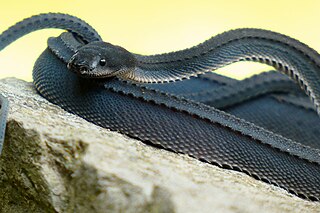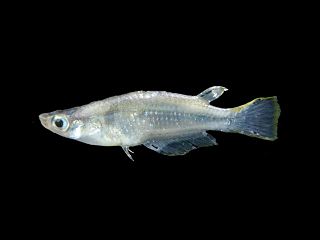
The lesser adjutant is a large wading bird in the stork family Ciconiidae. Like other members of its genus, it has a bare neck and head. It is however more closely associated with wetland habitats where it is solitary and is less likely to scavenge than the related greater adjutant. It is a widespread species found from India through Southeast Asia to Java.

The Acrochordidae, commonly known as wart snakes, Java wart snakes, file snakes, elephant trunk snakes, or dogface snakes are a monogeneric family created for the genus Acrochordus. This is a group of primitive aquatic snakes found in Australia and tropical Asia. Currently, three species are recognized.

The marine hatchetfishes or deep-sea hatchetfishes as well as the related bottlelights, pearlsides and constellationfishes are small deep-sea ray-finned fish of the stomiiform family Sternoptychidae. They are not closely related to and should not be confused with the freshwater hatchetfishes, which are teleosts in the characiform family Gasteropelecidae. The Sternoptychidae have 10 genera and about 70 species altogether.

The banteng, also known as tembadau, is a species of cattle found in Southeast Asia. The head-and-body length is between 1.9 and 3.68 m. Wild banteng are typically larger and heavier than their domesticated counterparts, but are otherwise similar in appearance. The banteng shows extensive sexual dimorphism; adult bulls are generally dark brown to black, larger and more sturdily built than adult cows, which are thinner and usually pale brown or chestnut red. There is a big white patch on the rump. Horns are present on both sexes, and are typically 60 to 95 cm long. Three subspecies are generally recognised.

Mueller's pearlside or Mueller's bristle-mouth fish, Maurolicus muelleri, a marine hatchetfish of the genus Maurolicus, is found in deep tropical, subtropical and temperate waters of the Pacific Ocean and the Atlantic Ocean, from the surface to depths of 1,500 metres (4,900 ft). Its can grow up to 8 centimetres (3.1 in) at maximum.
The Java pipistrelle is a species of pipistrelle bat found in South and Southeast Asia, including Afghanistan; Bangladesh; Brunei; Cambodia; China; India; Indonesia; Laos; Malaysia; Myanmar; Nepal; Pakistan; Philippines; Singapore; Thailand and Vietnam. It favors human habitations. A 2010 research paper from the Philippines regarding the prevalence of coronavirus in bats tested several Java pipistrelle bats.

The giant moray is a species of moray eel and a species of marine fish in the family Muraenidae. In terms of body mass, it is the largest moray eel; however, the slender giant moray is the largest in terms of body length.

The Java mouse-deer is a species of even-toed ungulate in the family Tragulidae. When it reaches maturity it is about the size of a rabbit, making it the smallest living ungulate. It is found in forests in Java and perhaps Bali, although sightings there have not been verified.

Xenodermus javanicus, also known as the Dragon Snake, Javan Tubercle Snake, Javan Mudsnake, or Rough-backed Litter Snake, is a small non-venomous, semi-fossorial Colubrid snake belonging to the monotypic genus Xenodermus. This species is best known for their characteristic dorsal scales and interesting defense mechanism in which they stiffen their entire bodies when threatened. X. javanicus is nocturnal and subsists on a diet of frogs, tadpoles and small fish. While they are known to perish once placed into captivity, some herpetoculturists have been successful in keeping them.

Acrochordus javanicus, commonly known as the elephant trunk snake or the Javan file snake, is a species of snake in the family Acrochordidae, a family which represents a group of primitive non-venomous aquatic snakes. The species is also kept as an exotic pet.

Boeng Tonle Chhmar is a 145.6 km2 (56.2 sq mi) large multiple use management area in Cambodia bordering Tonlé Sap lake that was established in 1999. It is located in Peam Bang Commune in Kampong Thom Province.

The roving coral grouper, also known as the spotted coral grouper, is a species of marine ray-finned fish, a grouper from the subfamily Epinephelinae which is part of the family Serranidae, which also includes the anthias and sea basses. It is found in the Indo-Pacific, although the Red Sea taxon, P.. marisrubri, is regarded as a separate species by some authorities.
The Java razorfish is a doubtful species of wrasse about which little is known. This fish gets the name "javanicus" from Java, Indonesia, from which the type specimen was supposedly obtained. Also, some fish have been reported to have been spotted in the Red Sea. The validity of this species is questioned pending further studies.

Oryzias javanicus, the Javanese ricefish, is a small species of fish in the family Adrianichthyidae. It lives in Peninsular Thailand, Malaysia, Singapore, and Indonesia, where it can be seen in both brackish and fresh water in ponds, ditches, mangrove, swamps, streams and canals.

Poisonous fish are fish that are poisonous to eat. They contain toxins which are not destroyed by the digestive systems of animals that eat the fish. Venomous fish also contain toxins, but do not necessarily cause poisoning if they are eaten, since the digestive system often destroys their venom.
The Washington Department of Fish and Wildlife (WDFW) is a department of the government of the state of Washington, United States of America. The department's history starts with the appointment of a fisheries commissioner in 1890 by Governor of Washington Elisha P. Ferry. The department is overseen by a director appointed by the Washington Fish and Wildlife Commission; Kelly Susewind was appointed to the position in June 2018.
Brachyplatystoma filamentosum, the piraíba or kumakuma, is a species of large catfish of the family Pimelodidae and genus Brachyplatystoma that is native to Amazon and Orinoco River basins and fluvials in Guianas and northeastern Brazil.

The headlight fish is a species of lanternfish in the family Myctophidae. It is also sometimes referred to as the headlight lanternfish, or even the lanternfish, though it is not the only species to be called this.
Stanley Howard Weitzman was a Research Scientist Emeritus at Division of Fishes, National Museum of Natural History, Washington, D.C.












